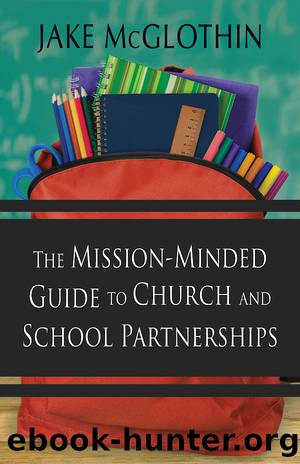The Mission-Minded Guide to Church and School Partnerships by McGlothin Jake;

Author:McGlothin, Jake;
Language: eng
Format: epub
Publisher: Abingdon Press
Published: 2017-08-15T00:00:00+00:00
3. CAMP HUTCHISON
I mentioned earlier that our senior pastor once asked the principal of Hutchison Elementary School, âWhat keeps you up at night?â The principal responded, âThe summer.â She didnât know what her students were doing to fill their time, but she knew they were losing much of their learning.
Due to economic issues, Fairfax County Public Schools no longer held summer school programs except for special education students. We realized that many lower-income students across the county would benefit greatly from additional learning and enrichment in the summer.
In 2011, reading comprehension was one of the driving factors for developing a summer enrichment program. For lower-income students without access to education materials, parental supervision, or regular English language conversation during the summer, challenges in the fall were huge. According to bestselling author Malcolm Gladwell, âWhen it comes to reading skills, poor kids learn nothing when school is not in session.â21 Studies have shown, most notably by the Annie E. Casey Foundation in its report called âEarly Warning! Why Reading by the End of Third Grade Matters,â students who read at a third-grade level by the third grade enjoy radically improved learning.22
In Gladwellâs book Outliers, the author spends an entire chapter on the gap in education between middle-and upper-class students and lower-class students. He suggests that while innovations in class style, reduction in class sizes, and the introduction of new technology may be beneficial for reducing that gap, it may be simpler. In fact, studies have shown increasing the length of the school year for low-income students virtually eliminates the gap.23
As I mentioned previously, summer enrichment for children who do not have the means to participate in activities in the community was a major concern for the school principal. For students whose families live at or below the poverty line, summer can be a time of little supervision and educational enrichment. For those students on the free or reduced-price lunch program, a nutrition gap undoubtedly exists in the summer due to the additional costs of food for families. Without enrichment activities during the summer, students may also have difficulty during the first few months of school. Instead of beginning new material, they must spend a significant amount of time reviewing the previous yearâs curriculum.24
As youâve seen, Camp Hutchison was planned as a four-week enrichment program for up to one hundred students entering first, second, and third grades, with preference given to students selected by the school staff. The camp was held at the school, which was easily accessible and familiar to neighborhood children. The studentsâ learning focused on reading and math, but they also had an opportunity to participate in enrichment activities such as arts and crafts, music, science, and drama. County buses provided the transportation for a majority of the students, and breakfast and lunch were provided daily through the USDAâs Free Summer Meals Program, a program available nationwide. Volunteers acted as instructors and assistant instructors, counselors and junior counselors, nutrition volunteers, and enrichment volunteers. Over 150 members of the church and the surrounding community volunteered during the 2011 camp and 120 in 2012.
Download
This site does not store any files on its server. We only index and link to content provided by other sites. Please contact the content providers to delete copyright contents if any and email us, we'll remove relevant links or contents immediately.
To Begin at the Beginning by Copenhaver Martin B.;(60)
Stay in the City by Gornik Mark R.;Wong Maria Liu;Keller Timothy;Acevedo Peter & Miriam Yvette;(60)
Liberal Arts for the Christian Life by Jeffry C. Davis(57)
Teaching the Faith, Forming the Faithful by Parrett Gary A.;Kang S. Steve;Packer J. I.;(56)
Processing the Plan of God Through Prayer by Mark Brazee(52)
Approaching the Study of Theology: An Introduction To Key Thinkers, Concepts, Methods And Debates by Anthony C. Thiselton(45)
Principles of Catholic Social Teaching by David A. Boileau(43)
Why Do We Suffer and Where Is God When We Do? by Valerie G. Rempel(42)
Two Tasks by Charles Malik(37)
Life Explore Soul by Sakulchai Sikitikul(32)
God's Greater Glory by Bruce A. Ware(19)
